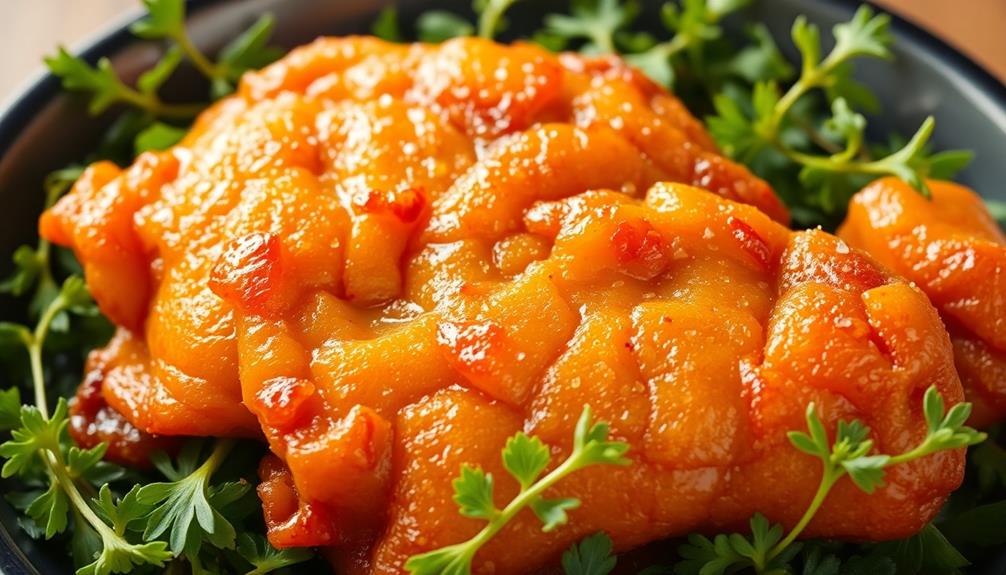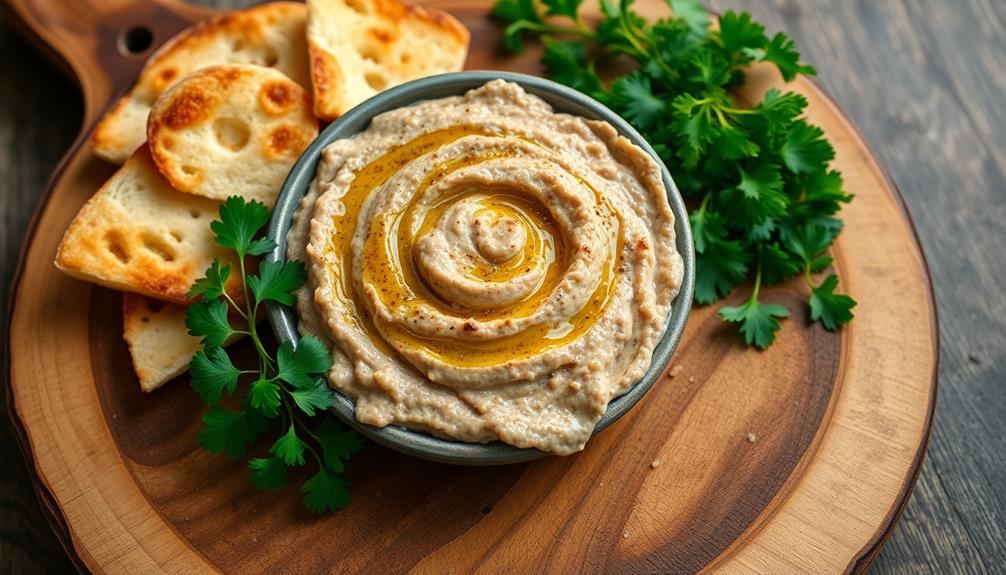Taramasalata, the beloved Greek fish roe dip, boasts a rich history tracing back to ancient times when it was a delicacy for the elite. This creamy, umami-rich spread evolved across the Mediterranean, becoming a cherished part of Greek cuisine. To make it, you'll soak and finely chop cured fish roe, then blend it with olive oil, lemon juice, bread, and seasoning for a balanced, velvety texture. Serve chilled with pita or veggies for a taste of Mediterranean culture. If you'd like to dive deeper into the history and preparation of this delightful dip, keep reading.
Key Takeaways
- Taramasalata is a traditional Greek dip made from cured and salted fish roe, typically carp or cod, blended with bread, olive oil, and lemon juice.
- The dish has historical roots tracing back to ancient Greece and gained prominence during the Byzantine Empire, reflecting Mediterranean dietary culture.
- Preparation involves soaking the fish roe to remove saltiness, chopping it, and blending it with the other ingredients to achieve a creamy, flavorful dip.
- Taramasalata features a salty, umami-rich flavor profile, complemented by the tanginess of lemon and the richness of olive oil, making it a versatile appetizer or spread.
- The dip is rich in omega-3 fatty acids from the fish roe and healthy fats from the olive oil, providing a nutritious option for health-conscious eaters.
History
The origins of taramasalata can be traced back to ancient Greece, where it served as a delicacy among the wealthy and powerful. These privileged individuals savored the salty, creamy spread made from cured fish roe, often paired with crusty bread or fresh vegetables.
Over time, this traditional Greek dish evolved, with regional variations emerging across the Mediterranean. As the Byzantine Empire flourished, taramasalata gained prominence, becoming a staple on the tables of the imperial court.
The recipe spread throughout the region, adapting to local tastes and ingredients. In the modern era, taramasalata has become a beloved part of Greek cuisine, found in tavernas and households across the country.
Whether served as a dip, spread, or accompaniment, this iconic dish continues to delight and inspire food enthusiasts around the world.
Recipe
Taramasalata is a traditional Greek dip made from cured and salted fish roe, usually from carp or cod. It has a rich, creamy texture and a delicate, slightly salty flavor. This recipe will guide you through the process of creating a homemade version of this beloved dish.
The key to a successful taramasalata is the quality and freshness of the fish roe. Look for high-quality, moist roe that has been properly cured and preserved. Avoid roe that appears dry or discolored, as it may impart an unpleasant bitterness to the final dish.
- 200g cured and salted fish roe (carp or cod)
- 100g bread, soaked in milk and squeezed dry
- 2 tablespoons lemon juice
- 1/2 cup olive oil
- 1/4 cup water
- Salt and pepper to taste
Begin by rinsing the fish roe under cold water to remove any excess salt. In a food processor, combine the roe, bread, lemon juice, and a splash of the water. Blend until the mixture becomes smooth and creamy.
Slowly drizzle in the olive oil while the processor is running, and continue blending until the dip reaches the desired consistency. If the mixture appears too thick, add more water a tablespoon at a time until it reaches the desired texture. Season with salt and pepper to taste.
Once the taramasalata is prepared, it's best to let it rest in the refrigerator for at least 30 minutes to allow the flavors to meld.
Serve chilled, accompanied by pita bread, raw vegetables, or crackers. Enjoy this rich and flavorful dip as a tasty appetizer or a versatile accompaniment to your favorite Mediterranean-inspired meal.
Cooking Steps
First, soak the fish roe in water to soften it.
Drain the roe and finely chop it before blending it with olive oil, lemon juice, and your desired seasonings.
Step 1. Soak the Fish Roe in Water
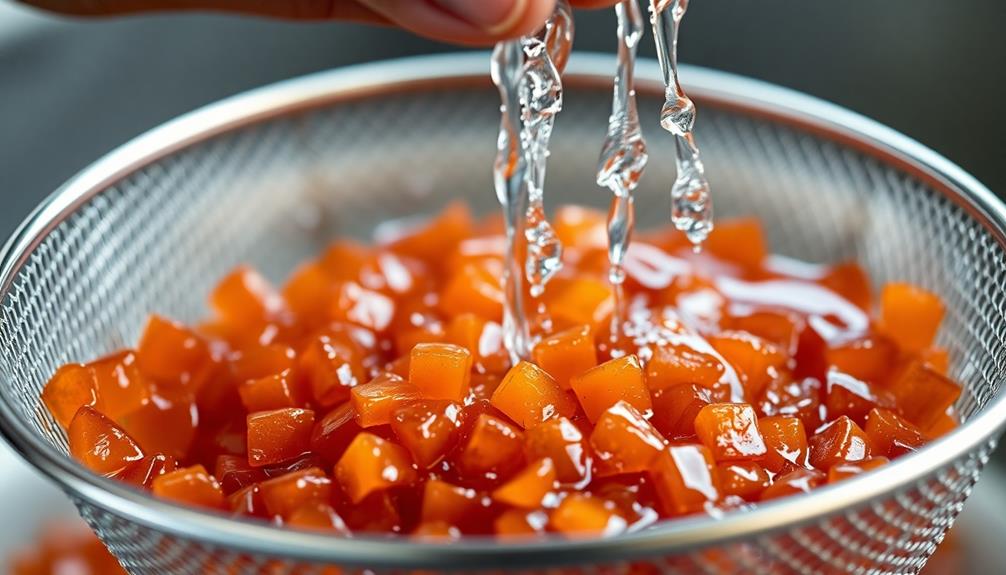
To prepare the taramasalata, you'll need to soak the fish roe in water. Start by placing the fish roe in a bowl and covering it with fresh, cool water. Let it soak for 30 to 60 minutes, gently stirring it occasionally. This helps to remove the saltiness and mellows the intense flavor of the roe.
As the roe soaks, you'll notice the water turning a pale pink or reddish hue. This is normal and indicates the roe is releasing its natural oils and flavors into the water.
After the soaking time, drain the roe in a fine-mesh sieve, discarding the soaking water. Gently pat the roe dry with paper towels, being careful not to break up the delicate globules.
The softened, desalted roe is now ready to be incorporated into the taramasalata dip. This simple step helps create the signature creamy, mild-flavored spread you'll enjoy.
Step 2. Drain and Finely Chop the Fish Roe
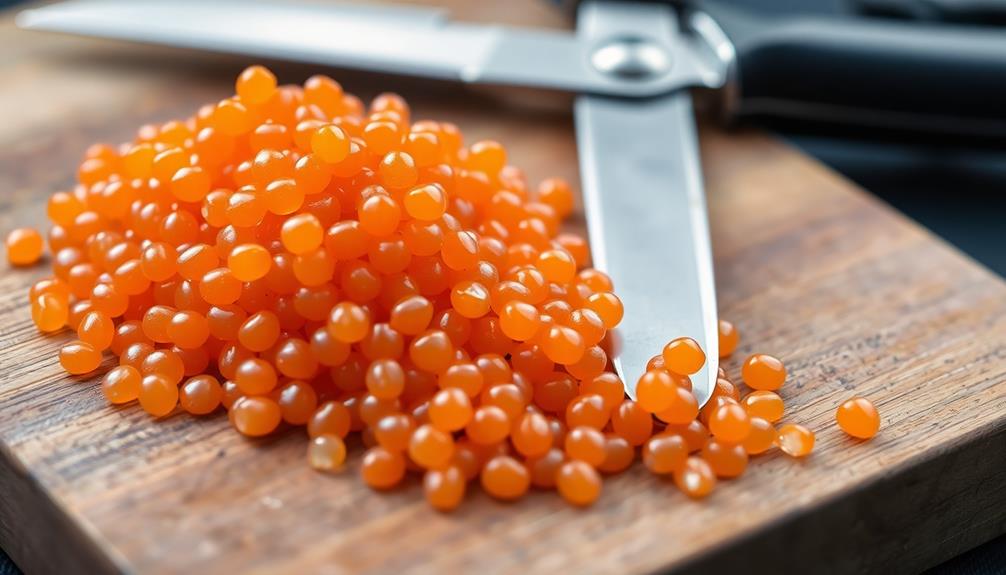
After soaking the fish roe, drain it in a fine-mesh sieve, discarding the soaking water. Once drained, use a sharp knife to finely chop the roe. You'll want to mince it into small, evenly-sized pieces – about the size of coarse breadcrumbs.
Take your time with this step, as chopping the roe well is crucial for the smooth, creamy texture of the taramasalata. As you work, you may notice the roe releases a bit of liquid. That's perfectly normal.
Simply blot the chopped roe gently with a paper towel to remove any excess moisture. This will help the flavors meld together nicely when you begin mixing the dip.
With the roe prepped, you're one step closer to enjoying this classic Greek appetizer. The finely chopped texture will ensure the roe is evenly distributed throughout the dip, offering a lovely, delicate brininess in every bite.
Get ready to wow your guests with this flavorful and authentic taramasalata!
Step 3. Blend Roe, Olive Oil, Lemon Juice

With the finely chopped fish roe ready, you'll want to grab a food processor or high-powered blender. Add the roe, a generous drizzle of your best olive oil, and a squeeze of fresh lemon juice. The combination of these simple ingredients is key to crafting the perfect taramasalata.
Pulse the mixture a few times, allowing the roe to break down and incorporate with the oil and lemon. Continue blending, stopping to scrape down the sides as needed, until the dip reaches a smooth, creamy consistency.
You're looking for a light, fluffy texture that's not too thick or too thin. Taste and adjust the seasoning, adding more lemon juice for brightness or a touch more oil for creaminess.
Once you've achieved the desired flavor and texture, transfer the blended taramasalata to a serving bowl. Smooth the top and drizzle with a bit of extra virgin olive oil for a polished presentation.
Refrigerate until ready to serve with warm pita bread or crunchy vegetables.
Step 4. Adjust Seasoning to Taste
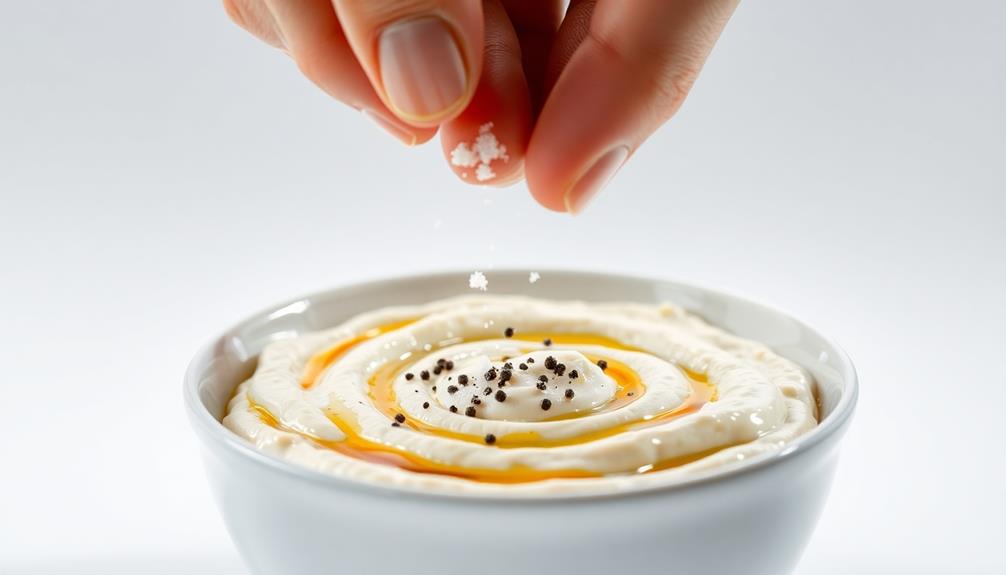
Having blended the mixture to a smooth, creamy consistency, taste the taramasalata and adjust the seasoning to your preference.
You may want to add a bit more lemon juice for a brighter flavor or a pinch of salt to bring out the richness of the fish roe. Dip your finger in and give it a try, then make any tweaks needed until the balance of flavors is just right for your taste buds.
Don't be afraid to experiment – the beauty of homemade taramasalata is that you can customize it to your liking. A dash of pepper can lend a subtle heat, while a sprinkle of paprika adds a smoky undertone.
Gently stir in your chosen seasonings, sampling after each addition, until you achieve the perfect blend. The goal is a well-seasoned dip that tantalizes your palate and leaves you craving more.
Step 5. Refrigerate Before Serving
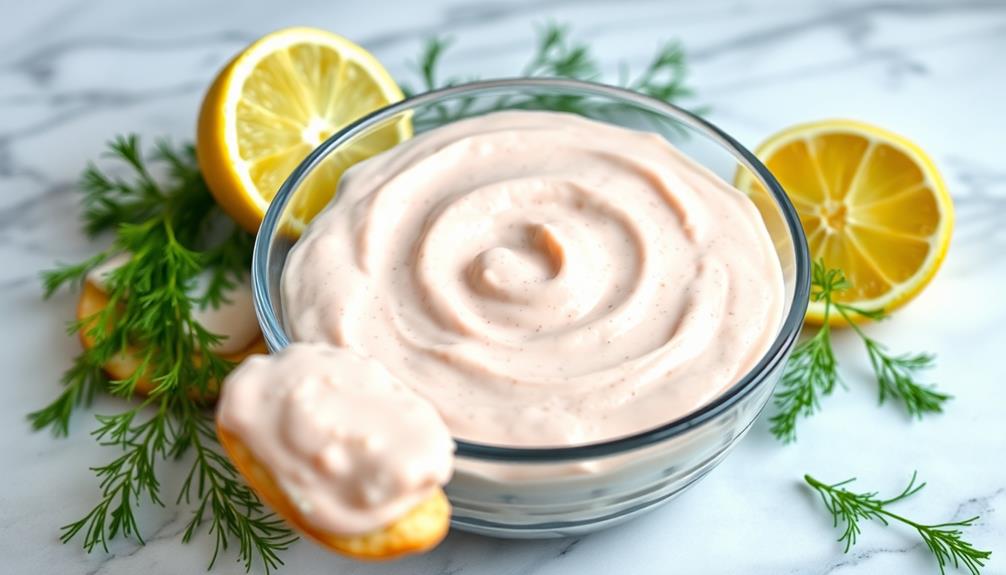
Once you've adjusted the seasoning to your liking, it's time to chill the taramasalata before serving. This creamy, savory dip is best enjoyed cold, as the flavors will meld and intensify as it rests in the fridge.
Carefully transfer the dip to an airtight container and place it in the refrigerator for at least 30 minutes, or up to 2 hours. This chilling period allows the ingredients to fully incorporate, resulting in a luxuriously smooth and flavorful taramasalata.
As the dip chills, the garlic and lemon juice will have a chance to mellow, while the rich, briny roe takes center stage. This combination of flavors creates a well-balanced dip that is perfect for serving with fresh vegetables or pita chips. Many people enjoy adding a drizzle of olive oil and a sprinkle of fresh herbs on top for an extra pop of flavor. Some even like to mix in a bit of mashed potato to create a more traditional recipe for skordalia. This versatile dip can also be used as a delicious spread for sandwiches or as a topping for grilled meats.
When you're ready to serve, give the container a gentle stir to ensure the flavors are evenly distributed. Scoop the chilled taramasalata onto fresh pita bread, crisp crudités, or your favorite crackers.
The cool, velvety texture and bold, umami-packed taste will delight your guests, making this dip a true crowd-pleaser.
Final Thoughts
Taramasalata, a beloved Greek dip, represents a delightful culinary experience that has stood the test of time. This unique blend of cured fish roe, olive oil, lemon juice, and bread creates a vibrant, creamy texture that tantalizes the taste buds.
While the preparation may seem intimidating, the end result is well worth the effort. As you dip a crisp pita into the velvety taramasalata, you'll be transported to the sun-drenched shores of Greece. The salty, umami-rich flavor pairs beautifully with the tanginess of the lemon and the richness of the olive oil.
It's a true celebration of the Mediterranean's bountiful flavors. Whether you're hosting a gathering or simply indulging in a solo snack, taramasalata is sure to delight. Its versatility makes it an excellent choice for appetizers, mezze platters, or even as a spread on crusty bread.
Embrace the traditional Greek flavors and let this iconic dip become a new favorite in your culinary repertoire.
Frequently Asked Questions
Is Taramasalata Suitable for People With Seafood Allergies?
No, taramasalata wouldn't be suitable for people with seafood allergies. Since it's made from fish roe, it contains seafood ingredients that could trigger an allergic reaction in those with seafood sensitivities. It's best to avoid this dish if you have a seafood allergy.
How Long Does Homemade Taramasalata Typically Last in the Fridge?
Homemade taramasalata typically lasts 3-5 days in the fridge when stored properly. Be sure to keep it covered and chilled to maintain freshness. Enjoy your dip while it's at its best!
Can Taramasalata Be Frozen for Later Use?
Yes, you can freeze taramasalata for later use. It'll keep in the freezer for up to 3 months. Just be sure to thaw it in the refrigerator before serving, and stir well to recombine any separated ingredients.
What Are Some Alternative Uses for Leftover Taramasalata?
You can use leftover taramasalata as a spread on toast, a dip for veggies, or even as a topping for baked potatoes. It's a versatile ingredient that can add flavor to various dishes.
Is Taramasalata a Traditional Greek Dish or Does It Have Other Origins?
You're curious about the origins of taramasalata, aren't you? Well, it's a traditional Greek dish, but it has influences from other Mediterranean cuisines as well. Its creamy texture and salty flavor make it a beloved staple in Greek cuisine.

